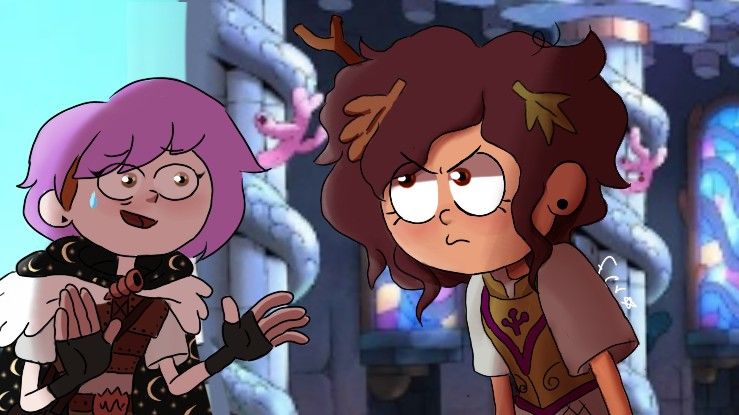The animated television landscape has been irrevocably altered by shows like Amphibia and The Owl House. These narratives, ostensibly targeted at younger audiences, resonate far beyond their intended demographic. Both weave intricate tapestries of friendship, self-discovery, and overcoming adversity. But what ignites the collective imagination about a hypothetical crossover, a convergence of these two distinct yet strangely analogous worlds? It’s more than just fan service; it’s a yearning for narrative synergy.
One of the most salient observations regarding Amphibia and The Owl House is their shared thematic DNA. Both series delve into the experiences of protagonists uprooted from their familiar surroundings and thrust into fantastical realms. Anne Boonchuy, the impulsive and occasionally reckless protagonist of Amphibia, stumbles into a world teeming with sentient amphibians. Likewise, Luz Noceda, the creatively exuberant protagonist of The Owl House, discovers a portal to the Boiling Isles, a demon realm brimming with magic and peril. The narratives are mirror images, yet the nuances in their execution warrant closer inspection.
The allure of a crossover lies not merely in the superficial similarities but in the potential for exploring contrasting narrative approaches. Amphibia leans into a more traditional heroic journey, chronicling Anne’s maturation from a self-centered teenager into a selfless leader. The Owl House, conversely, engages in a more deconstructionist approach, challenging conventional fantasy tropes. The series emphasizes found family and the subversion of established power structures. This divergence in narrative architecture creates fertile ground for compelling storytelling. Imagine Anne, steeped in the established hierarchies of Amphibia, encountering the anarchic spirit of the Boiling Isles, or Luz, accustomed to the unconventional pedagogies of Eda Clawthorne, navigating the structured societal norms of Newtopia.
Furthermore, the distinct magic systems of each world present intriguing possibilities. In Amphibia, magic is largely relegated to ancient artifacts and the innate abilities of certain creatures. This establishes a sense of mysticism and the unknown. In contrast, The Owl House presents a more codified system of glyph-based magic. Characters create spells by combining various runes. The potential for interweaving these disparate magical paradigms is significant. What would happen if Anne attempted to wield glyph magic? Could Luz decipher the secrets of the Calamity Box? The answers, though speculative, offer an engaging playground for narrative experimentation.
Beyond the mechanics of magic, the characters themselves represent compelling drivers for a crossover narrative. The dynamic between Anne and Luz, two protagonists grappling with questions of identity and belonging, presents a rich tapestry of potential interactions. The gruff yet endearing mentorship of Eda Clawthorne could be juxtaposed against the wise counsel of Sprig Plantar. The stoicism of Sasha Waybright could be contrasted with the impulsive nature of Willow Park. The possibilities are manifold. Consider the ethical dilemmas that would arise from the clash of ideologies. How would Anne’s ingrained sense of justice reconcile with the morally ambiguous actions sometimes undertaken by the residents of the Boiling Isles? How would Luz’s unwavering optimism fare against the pragmatic cynicism prevalent in Amphibia’s political landscape?
The antagonists of each series also offer intriguing avenues for exploration. Emperor Belos, the tyrannical ruler of the Boiling Isles, presents a formidable threat whose motivations are shrouded in mystery. King Andrias, the seemingly benevolent yet ultimately malevolent king of Amphibia, conceals his true intentions behind a facade of regal charm. A crossover could explore the potential for these two antagonists to forge an alliance. What nefarious schemes could they conjure if their combined intellects and resources were brought to bear on both worlds? Alternatively, a clash between Belos and Andrias, each vying for dominion, could provide a compelling central conflict. The strategic implications are vast, presenting opportunities for both protagonists to grow and adapt in unforeseen ways.
Moreover, the emotional core of each series hinges on the strength of its supporting characters. The unwavering loyalty of Sprig and Polly Plantar provides Anne with a vital anchor. The burgeoning romance between Luz and Amity Blight adds an element of emotional depth to The Owl House. A crossover would necessitate careful consideration of these pre-existing relationships, exploring how they might be challenged, strengthened, or even transformed by the introduction of new characters and environments. The potential for heartwarming moments of camaraderie and poignant displays of vulnerability is boundless.
The thematic resonance between Amphibia and The Owl House extends beyond surface-level similarities. Both series explore profound themes of colonialism, political corruption, and the struggle for self-determination. A crossover could delve into these issues with greater nuance, utilizing the distinct cultural contexts of each world to illuminate the complexities of power dynamics and social injustice. The narratives could function as allegories for real-world issues, prompting viewers to critically examine their own perceptions of the world around them.
Ultimately, the yearning for an Amphibia and The Owl House crossover transcends mere fan speculation. It represents a collective desire for narratives that are both entertaining and intellectually stimulating. It is a testament to the power of animation to transcend genre conventions and explore complex themes with depth and sensitivity. The potential for storytelling synergy is immense. The convergence of these two worlds holds the promise of an unforgettable narrative experience. The crossover is not merely a “what if” scenario but a testament to the enduring appeal of compelling storytelling.
